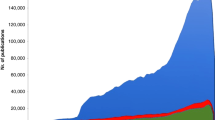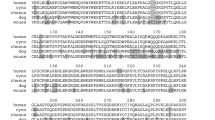Abstract
The enhanced pre- and postnatal (ePPND) study design has been developed in response to new scientific knowledge and subsequent guideline changes [ICH M3(R2) and ICH S6(R1)]. The changes in study design were basically driven by the experiences obtained during preclinical development of biopharmaceuticals. The standard ePPND concept does not apply to conventional small molecule pharmaceuticals. In essence, the ePPND design is a pre- and postnatal development (PPND) study in which key elements of an embryo-fetal development study are investigated in newborns and infants rather than in the fetus. The cynomolgus monkey is the current relevant nonhuman primate model. The ICH S6(R1) guideline reached step 5 in June 2011 and provides detailed recommendations on various parameters and the conduct of an ePPND study. This chapter provides working guidance for monitoring menstrual cycles to generate pregnant animals, ultrasound monitoring of pregnancy, morphometric measurements of fetuses and newborns, in vivo skeletal examination, various protocols for evaluation of infants (e.g., neurobehavioral assessment, learning and memory test, grip strength, immune system evaluation) and a comprehensive list of additional infant evaluation parameters for the cynomolgus monkey.
Access this chapter
Tax calculation will be finalised at checkout
Purchases are for personal use only
Similar content being viewed by others
References
ICH (2005) ICH harmonised tripartite guideline detection of toxicity to reproduction for medicinal products & toxicity to male fertility S5(R2). http://www.ich.org/fileadmin/Public_Web_Site/ICH_Products/Guidelines/Safety/S5_R2/Step4/S5_R2__Guideline.pdf. Accessed 4 Sept 2011
ICH (2011) ICH guideline S6 (R1): preclinical safety evaluation of biotechnology-derived pharmaceuticals. http://www.ema.europa.eu/docs/en_GB/document_library/Scientific_guideline/2009/09/WC500002828.pdf. Accessed 4 Sept 2011
Van der Laan JW, Pentsuk N (2011) ICH S6 regulatory reproduction studies to support the use of monoclonal antibodies. In: Weinbauer GF, Vogel F (eds) Future trends in primate toxicology and biotechnology. Waxmann, Muenster, pp 143–162
Chapman K et al (2007) Preclinical safety testing of monoclonal antibodies: the significance of species relevance. Nat Rev Drug Discov 6:120–126
Chapman K et al (2009) Preclinical development of monoclonal antibodies: considerations for the use of non-human primates. MAbs 1:505–516
Chapman K et al (2010) The future of non-human primate use in mAb development. Drug Discov Today 15:235–242
Martin PL et al (2009) Considerations in assessing the developmental and reproductive toxicity potential of biopharmaceuticals. Birth Defects Res B Dev Reprod Toxicol 86:176–203
Martin PL, Weinbauer GF (2010) Developmental toxicity testing of biopharmaceuticals in nonhuman primates: previous experience and future directions. Int J Toxicol 29:552–568
Pentšuk N, van der Laan JW (2009) An interspecies comparison of placental antibody transfer: new insights into developmental toxicity testing of monoclonal antibodies. Birth Defects Res B Dev Reprod Toxicol 86:328–344
Stewart J (2009) Developmental toxicity testing of monoclonal antibodies: an enhanced pre and postnatal design option. Reprod Toxicol 28:220–225
Stewart J (2008) Developmental/reproductive study design options for monoclonal antibodies. In: Weinbauer GF, Vogel F (eds) Critical contributions of primate models for biopharmaceutical drug development. Waxmann, Münster, pp 101–112
Chellman GR et al (2009) Developmental and reproductive toxicology studies in nonhuman primates. Birth Defects Res B Dev Reprod Toxicol 83:1–17
Jarvis P et al (2010) The cynomolgus monkey as a model for developmental toxicity studies: variability of pregnancy losses, statistical power estimates and group size considerations. Birth Defects Res B Dev Reprod Toxicol 89:175–187
Weinbauer GF et al (2008) Reproductive/developmental toxicity assessment of biopharmaceuticals in nonhuman primates. In: Cavagnaro JA (ed) Preclinical safety evaluation of biopharmaceuticals. A science-based approach to facilitating clinical trials. Wiley, New Jersey, pp 379–397
van Esch E et al (2008) Summary comparisons of female reproductive system in human and the cynomolgus monkey. Toxicol Pathol 36:171S–172S
Weinbauer GF et al (2011) Objective groups size determination for developmental toxicity studies in a nonhuman primate model (Macaca fascicularis). In: Weinbauer GF, Vogel F (eds) Future trends in primate toxicology and biotechnology. Waxmann, Muenster, pp 81–94
Luetjens CM, Weinbauer GF (2010) Relevant parameters for pregnancy outcome in the cynomolgus monkey. 49th Ann Mtg Soc Toxicol, Salt Lake City, poster 392
Golub MS et al (1985) Studies of marginal zinc deprivation in rhesus monkeys: infant behavior. Am J Clin Nutr 42:1229–1239
Golub MS, Sassenrath EN, Chapman LF (1981) Mother-infant interaction in rhesus monkeys treated clinically with delta-9-tetrahydrocannabinol. Child Dev 52:389–392
Weinbauer GF, Fuchs A, Niehaus M, Luetjens CM (2011) The enhanced pre- and postnatal study for nonhuman primates: updates and perspectives. Birth Defects Res C Embryo Today Reviews 93:324–333
Acknowledgments
The authors wish to specifically acknowledge the dedicated and competent work of our laboratory technical staff.
Author information
Authors and Affiliations
Corresponding author
Editor information
Editors and Affiliations
Rights and permissions
Copyright information
© 2013 Springer Science+Business Media, LLC
About this protocol
Cite this protocol
Weinbauer, G.F., Luft, J., Fuchs, A. (2013). The Enhanced Pre- and Postnatal Development Study for Monoclonal Antibodies. In: Barrow, P. (eds) Teratogenicity Testing. Methods in Molecular Biology, vol 947. Humana Press, Totowa, NJ. https://doi.org/10.1007/978-1-62703-131-8_15
Download citation
DOI: https://doi.org/10.1007/978-1-62703-131-8_15
Published:
Publisher Name: Humana Press, Totowa, NJ
Print ISBN: 978-1-62703-130-1
Online ISBN: 978-1-62703-131-8
eBook Packages: Springer Protocols




